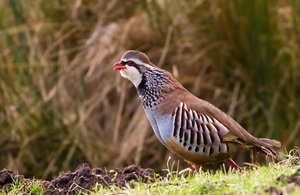Defra concludes its review into releasing gamebirds on and around protected sites
Defra has concluded its review into how gamebird releases on or near European protected sites are managed.

A red-legged partridge in a field
The review looked at areas including the number of gamebirds released and their impact on protected sites, the consenting process, and whether further safeguards could be provided to protect sites.
The review has now concluded and found that the negative effects of gamebird releases on protected sites tend to be localised and that there are minimal or no effects beyond 500m from the point of release. It also highlighted a need to gain a better understanding of how any impacts - particularly local ones - might be mitigated.
In response to a pre-action protocol letter from Wild Justice in July 2019, last September Defra accepted that in principle the annual release of non-native gamebirds on, or affecting, Special Areas of Conservation (SACs) and Special Protection Areas (SPAs) is capable of constituting a “plan or project” requiring appropriate assessment within the meaning of the Habitats Directive.
While not accepting the argument that current laws do not provide for appropriate assessment in such cases, Defra undertook a review to consider the legislative arrangements around the relevant activities and whether there are ways in which their effectiveness could be improved.
Environment Secretary, George Eustice, said:
The negative effects of gamebird releases on protected sites tend to be localised with minimal or no effects beyond 500m from the point of release.
However, our review highlighted a need to gain a better understanding of how any localised impacts might be mitigated and existing arrangements strengthened. The introduction of an interim licensing regime for next year will enable us to manage any potential impacts while gathering more information where evidence gaps exist. We will continue to engage and consult with industry in order to minimise any disruption.
The SoS has proposed a number of measures as a result of the review:
- A new interim licensing regime for the 2021 releases of common pheasant and red-legged partridge within European protected sites and within a 500m buffer zone around these sites.
- Improvements to the Animal and Plant Health Agency (APHA) poultry register.
- Review and improve the existing consenting regime.
- Improve monitoring of SACs and SPAs.
Defra will continue to consult with industry early in order to minimise any disruption.
Further information:
What to do if you release gamebirds on protected sites
The new interim licensing regime will be in place for the 2021 releases. The detail of this will be informed by consultation. Details of the consultation process will be announced shortly.
The Gamebird Release Review team can be contacted on GLTeam@defra.gov.uk for further information.
The introduction of an interim licensing regime
The new licensing regime is an interim measure for the 2021 releases of common pheasant and red-legged partridge within European protected sites and within a 500m buffer zone around the sites.
The interim licensing regime will be revisited once further evidence has been gathered to enable a site-specific appraisal of the impacts of gamebird release.
Defra will also ensure the interim regime is proportionate and will set out how key aspects of it will work ahead of the key planning stages for shoots to minimise disruption on them.
Subject to further consideration, the preferred option here is likely to be a general licence. General licences do not require an application to be made and there is no fee.
General licences set out conditions that must be complied with in order to rely on the licence. The licence to be introduced in respect of releases of common pheasant and red-legged partridge is likely to have conditions relating to the number of birds, density of release and location of key infrastructure. This is because the evidence is that effects are significantly reduced where birds are released in smaller numbers and at lower densities. However, the precise thresholds for any conditions are subject to further consideration and consultation. The intention is that where shoots cannot meet the conditions of the general licence, they will have the option to apply to NE for an individual, bespoke licence, a process which enables the impacts on the specific protected sites in question to be considered.